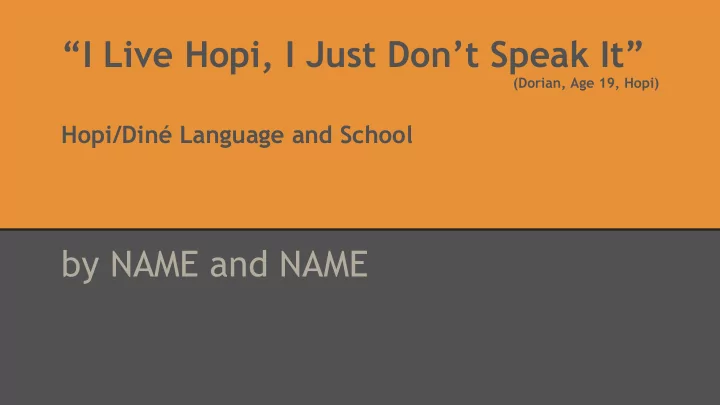

“I Live Hopi, I Just Don’t Speak It” (Dorian, Age 19, Hopi) Hopi/Diné Language and School by NAME and NAME
Why Language? ● Both minoring in TESL (Teaching English a Second Language) ● Native American Languages are becoming lost. ● Language is a vital part of the Hopi and Dine culture. ● Everyone we spoke with that did not speak their native language; wished that they could.
Why Language? In this country, 165 Native American languages are still spoken. ➢ 74 almost extinct (45%) ➢ 58 with fewer than 1,000 speakers (35%) ➢ 25 with 1,000-10,000 speakers (15%) ➢ 8 with 10,000 + speakers (5%) “If our language dies, if our culture dies, we die as a people to the world…” Darryl Kipp, Blackfeet Reservation Immersion Co-Director
History of Native American Language "My grandchild, the whites have many things which we Navajos need. But we cannot get them. It is as though the whites were in a grassy canyon and there they have wagons, plows, and plenty of food. We Navajos are up on a dry mesa. We can hear them talking but we cannot get to them. My grandchild, education is the ladder. Tell our people to take it." “My children, as you journey throughout life from generation to generation; do not forget Chief Manuelito - Dine your language, your culture, and your way of life. That identifies who you are.”
History - Hopi In 1880, traditional Hopi leader Chief Loololma, from the village of Oraibi traveled to Washington, D.C.Upon his return,Loololma said: “My children, let us not be afraid of the days to come.The pahaana way of life is here to stay and we must accept that. I feel in my heart that we can find a way to survive as a people. I say to you all... learn the white man’s tongue and learn how he thinks. Learn his ways so that we can all survive with it.”
History Continued A treaty in 1868 required the U.S. government to provide an education at the rate of one teacher ● for every thirty children between the ages of six and sixteen. At one time, Indigenous people had a traditional system of education which allowed and provided ● the means by which their culture could be passed on, changed and retained. The development and reliance on off-reservation boarding schools was a major device where formal ● education was effected. The objective was the destruction of the indigenous culture by removing the child far from the ● harmful influence of home and family. Many teachers believed that the future success of their students rested in the degree that they ● forgot their native language, culture and history and become “real Americans” who believed in the dominant society and its way of life. For today, so much damage has been done that we now must undo. ●
Navajos as they arrived at the Carlisle Boarding School
Navajos six months later
Observations/Perspective ● Winifred’s boarding school experience ● Hopi language is a fundamental aspect of living Hopi. ● Sheilah Nicholas “My mother’s words, when you were a child, you were fully Hopi.” ● Many students said they spoke Navajo, but in reality, they spoke very little. ● Most people we encountered spoke to us in English. https://www.youtube.com/watch?v=OTfVIPLi4dk
Observations/Perspective Tuba City Jr. High - limited number of students taking Hopi - 45 minutes per day - no homework, or student notes Bluff Elementary - Heritage Language Program - One teacher for all grades - Dance Tse Bii’Nitzgai Elementary School - Heritage Language Program - Native language present in classroom
Observations/Perspective Continued
Immediate Action ● Respect their individualism, their culture, their language. ● Educate the masses. ● Donations The Indigenous Language Institute provides vital language related services to Native communities so that their With values instilled through traditional teachings, individual identities, traditional wisdom and values are passed Hopi tribal leaders today still follow the visions of on to future generations in their leaders before them as each has an aspiration to original languages. ensure educational opportunities will continue to exist for the Hopi people.
Future Action ● Support Video about ● Immersion Schools on the Immersion Schooling Reservations. ● Bring college to the Reservation. ● Scholarships ● Bring students to college in groups.
Conclusions “To choose to use a language is an act of identity or belonging to a particular community.” This unwavering loyalty to their indigenous way of life has sustained many Native Americans for centuries.
Conclusions
Resources Winifred-Personal Interview Kyle-Personal Interview Allen, J. (2007). Creating Welcoming Schools: A Practical Guide to Home School Partnerships with Diverse Families. Newark: Teachers College Press. Freire, Paulo. Pedagogy of freedom: ethics, democracy, and civic courage Critical perspectives Gonzalez-Mena, J. (2010). 50 Strategies for Communicating and Working with Diverse Families. Upper Saddle River: Pearson Education, Inc.
Recommend
More recommend